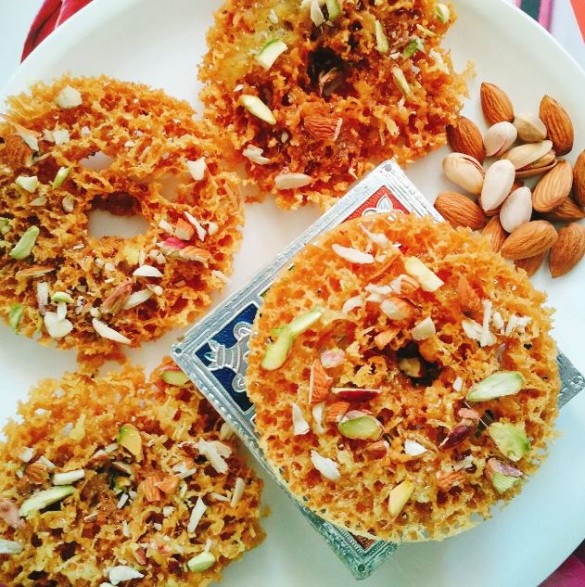
India is renowned for its diverse culinary traditions, and its sweets hold a special place in the hearts of its people. Among the myriad of delectable desserts, Ghewar stands out as a unique and beloved treat, especially during festive celebrations. It is a Rajasthani sweet traditionally associated with the Teej festival. It is available only during the rainy season for a month or two and then we have to wait for another year to enjoy this sweet treat. Although, now in some parts of India you can get it throughout the year.
It is a disc-shaped sweet and crispy cake, made of maida (refined flour), soaked in sugar syrup, and topped with some nuts. Making it is an art. A streak of thin batter goes into the hot ghee or oil and then it forms volcano-like bubbles which settle in a few seconds. Then again you release a streak of batter in the oil. It is repeated several times and then you get a honeycomb-like disc-shaped structure. Watching the making process is a treat to the eyes. This article explores the origins, preparation, and significance of Ghewar in Indian culture, making it a must-try delicacy for anyone with a sweet tooth.
Origins and Cultural Significance
Ghewar is a traditional Rajasthani sweet that originated in the royal kitchens of Rajasthan, India. Its history can be traced back several centuries when it was initially prepared as an offering to the local deities during auspicious occasions and religious festivals. Over time, Ghewar became an integral part of the culinary heritage of Rajasthan, and its popularity spread to other parts of India, especially during festivals like Teej, Gangaur, and Raksha Bandhan.
The Ghewar Experience
Ghewar is a sweet confection made from a unique combination of ingredients, including flour, ghee (clarified butter), milk, and sugar. The preparation process involves frying the batter in ghee to achieve a lacy, honeycomb-like texture. The result is a delicately crisp and porous disc-shaped dessert, which is then garnished with dry fruits, saffron strands, and sometimes a drizzle of sugar syrup for added sweetness.
Types of Ghewar
Ghewar comes in various forms, each offering a distinct taste and texture. The most common types include:
Plain Ghewar: The classic version of Ghewar, appreciated for its light and delicate flavor.
Mawa (Khoya) Ghewar: This variant features a layer of rich and creamy khoya (evaporated milk) on top of the Ghewar, adding a delectable richness to the dessert.
Malai Ghewar: A variant that boasts a topping of thickened milk cream (malai), imparting a creamy and velvety texture.
The Ghewar Making Process
The process of making Ghewar requires skill and precision, as achieving the perfect texture is crucial to its taste and appeal. To make Ghewar, a special Ghewar mold or ring is used, which is immersed in hot ghee. The batter is then poured into the mold, creating the iconic lacy design as it cooks. Once golden brown and crispy, the Ghewar is removed from the mold and left to cool. The result is a visually striking dessert that captivates with its intricate design.
Ghewar Season
When deep-fried, it comes out all crispy and it needs some moisture to become slightly soft. That is why it is made in the rainy season. In the rainy season, there is humidity. It absorbs the moisture in the air and becomes soft and tender. But now, the demand for crispy Ghevar is increasing. That’s why in some parts, you get it throughout the year.
Ghewar: A Festival Favorite
In India, Ghewar is synonymous with celebrations. During festivals and special occasions, sweet shops and households alike prepare batches of Ghewar to share with family and friends. The act of savoring this sweet delicacy has become a cherished tradition, bringing joy and happiness to those who indulge in its taste.
Ghewar is more than just a sweet; it is a cultural symbol of celebration and togetherness. The art of making Ghewar has been passed down through generations, preserving its traditional charm and authenticity. So, the next time you find yourself amidst an Indian festival, don't miss the opportunity to savor this delightful dessert. Ghewar is not just a treat for the taste buds but also an experience that offers a glimpse into the rich culinary heritage of India. Enjoy the crispy, airy texture and sweetness of Ghewar, and let it take you on a delightful journey through the flavors and traditions of Rajasthan.
Traditional Indian Desserts and Sweets
8 Delicious Low-Sugar Fruits for a Sweet and Healthy Diet
The Sweet Success of Sugar: Popular Beauty Brand in India